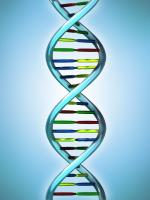|
This section contains 2,133 words (approx. 8 pages at 300 words per page) |

|
Overview
The "central dogma of molecular biology," elaborated shortly after James Watson (1928- ) and Francis Crick (1916- ) proposed their model of the DNA double helix, states that genetic information is encoded in the primary structure of nucleic acids and that this information is transferred to proteins. In summary, the path of information transfer is DNA→RNA→protein. That is, information in DNA, the genetic material, is transcribed into an RNA intermediate called messenger RNA, which is then translated into proteins. For many years, the central dogma served as a stimulus and a framework guiding investigations of genetic mechanisms at the molecular level. In order for scientists to understand how the genetic material found in the nuclei of all the cells in the body directs the special characteristics of highly differentiated cells, as...
|
This section contains 2,133 words (approx. 8 pages at 300 words per page) |

|


